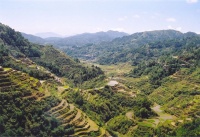Terrace (earthworks)
From The Art and Popular Culture Encyclopedia
|
Related e |
|
Featured: |
In agriculture, a terrace is designed to slow or prevent the rapid run-off of irrigation water. Often such land is formed into multiple terraces, giving a stepped appearance. The human landscapes of rice cultivation in terraces that follow the natural contours of the escarpments like contour plowing is a classic feature of the island of Bali, the Banaue Rice Terraces in Benguet, Philippines, and the rice terraced mountains of Yuanyang County, Yunnan and Longsheng County, Guanxi, both in the China. In Peru, the Inca made use of otherwise unusable slopes by drystone walling to create terraces. This form of land use is prevalent in many countries, and is used for crops requiring a lot of water, such as rice. Terraces are also easier for both mechanical and manual sowing and harvesting than a steep slope would be. Terracing slows down the speed of water and therefore allow more run-off to be sucked up by the soil.
Natural terracing, the result of small-scale erosion, is formed where cattle are grazed for long periods on steep sloping pasture. Sometimes, for example at Glastonbury Tor, the result is regular enough to give an impression of archaeological artifacts.
From its origins in agriculture the practice of formally terracing a sloping site evolved in gardening. The Hanging Gardens of Babylon could have been built on an artificial mountain with stepped terraces like those on a ziggurat. At the seaside Villa of the Papyri in Herculaneum, the villa gardens of Julius Caesar's father-in-law fell away giving pleasant and varied views of the Bay of Naples.
Terracing was also a method of soil conservation farming for the Inca. They used a system of canals and aqueducts to direct water through dry land and increase fertility.
The Incas constructed the terraces on the slopes of the Andes mountains. They cut step-like ledges into the mountainside, so they could be used as field, where they planted crops. Using terraces also stopped the rain from washing away the soil. This technique was so successful, it is still used in the Andes Mountains.
In old English, a terrace was also called a lynch and there is a fine example of a Lynch Mill in Lyme Regis, for which the water arrives via a river ducted along a terrace. This set-up was used in steep hilly areas in the UK.
See also


